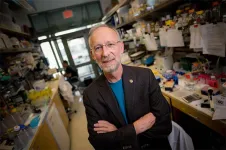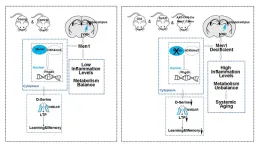(Press-News.org) More than a third of FDA-approved drugs work by targeting a G protein-coupled receptor, or GPCR. The human body has more than 800 types of GPCRs that provide cells with information about the external environment to calibrate responses. Drugs that either block or activate GPCRs are used to treat a wide range of diseases including hypertension, pain and inflammation. Most drugs bind to the outside of the receptor, but this can result in adverse side effects since receptors often resemble one another.
In a new study published in Nature, Sivaraj Sivaramakrishnan, a professor in the College of Biological Sciences, along with graduate student Fred Sadler and co-authors Michael Ritt and Yatharth Sharma, uncovered the role of the third intracellular loop in the GPCR’s signaling mechanism, suggesting the possibility of a more targeted approach to drug discovery and a paradigm shift for new therapeutics.
“Typical GPCR drugs act as on or off switches for cellular signaling outcomes,” said Sivaramakrishnan. “Drugs that leverage the loop effectively can act as signaling dimmer switches to more precisely control drug responses.”
The authors developed new biochemical and biophysical tools, combined with computational measurements by collaborators Ning Ma and Nagarajan Vaidehi at the City of Hope Cancer Center. They tracked how the third intracellular loop changes in shape, or conformation, through the receptor signaling process. In a breakthrough for the field, their data show that the loop acts as a kind of gate to ensure that receptors activate the correct type of G protein signaling at the right intensity.
“A key advantage of this loop is that it is highly unique, even among closely related receptors, making it an outstanding drug target,” said Sadler. “Developing drugs through this newly discovered mechanism would allow for far more targeted therapeutics.”
Funding was provided by the National Institutes of Health and the University of Minnesota Graduate School.
END
Protein engineers navigate toward more targeted therapeutics
New research on protein receptors could lead to breakthroughs in improving drug delivery.
2023-03-16
ELSE PRESS RELEASES FROM THIS DATE:
Antibody fragment-nanoparticle therapeutic eradicates cancer
2023-03-16
ITHACA, N.Y. -- A novel cancer therapeutic, combining antibody fragments with molecularly engineered nanoparticles, permanently eradicated gastric cancer in treated mice, a multi-institutional team of researchers found.
The results of the “hit and run” drug delivery system, published in the March issue of Advanced Therapeutics, were the culmination of more than five years of collaboration between Cornell, the Memorial Sloan Kettering Cancer Center (MSKCC) and biopharmaceutical company AstraZeneca.
“I’ve seen beautiful ...
Childhood volunteering encourages future voting in elections, study shows
2023-03-16
Childhood volunteering encourages those from politically disengaged homes to go on and vote when they are older, a major new study shows.
Community action leads to them becoming more interested in politics and to see voting as a duty, according to the research.
However volunteering didn’t have the same impact for most children, so it shouldn’t be seen as the answer to falling voter numbers.
The research was carried out by Dr Stuart Fox, now at the University of Exeter and conducted while he worked at Brunel University. He used the United Kingdom Household Longitudinal Survey and structural equation modelling to examine ...
Extinct animals on islands cannot be replaced
2023-03-16
Lush plants, large trees and many different, beautiful and colorful exotic animals. This is probably how most people imagine the small island of Mauritius in the Indian Ocean.
But that may not be the case. As in several other places in the world, the island and its nature are at risk of mass extinction, and in just a decade or two the flourishing nature and the many diverse animals may have dwindled to very few.
At least if the extinction of the many plants and animals on the island continues. They are part of a particularly sensitive ...
DNA treatment could delay paralysis that strikes nearly all patients with ALS
2023-03-16
In virtually all persons with amyotrophic lateral sclerosis (ALS) and in up to half of all cases of Alzheimer’s disease (AD) and frontotemporal dementia, a protein called TDP-43 is lost from its normal location in the nucleus of the cell. In turn, this triggers the loss of stathmin-2, a protein crucial to regeneration of neurons and the maintenance of their connections to muscle fibers, essential to contraction and movement.
Writing in the March 16, 2023 issue of Science, a team of scientists, led by senior study author Don Cleveland, PhD, Distinguished Professor of Medicine, Neurosciences and Cellular and Molecular Medicine at University ...
Loss of Menin helps drive the aging process, and dietary supplement can reverse it in mice
2023-03-16
Decline in the hypothalamic Menin may play a key role in aging, according to a new study publishing March 16th in the open access journal PLOS Biology by Lige Leng of Xiamen University, Xiamen, China, and colleagues. The findings reveal a previously unknown driver of physiological aging, and suggest that supplementation with a simple amino acid may mitigate some age-related changes.
The hypothalamus has been recognized as a key mediator of physiological aging, through an increase in the process ...
Dana-Farber researchers chart a course for understanding, preventing, and treating young-onset colorectal cancer
2023-03-16
Colorectal cancer among young people is increasing globally and rapidly. Experts expect it to become the leading cause of cancer death in individuals aged 20-49 in the U.S. by the year 2030.
Yet no one is certain why this disease is suddenly affecting so many young people. In a new paper published in Science, Dana-Farber Cancer Institute researchers outline the complexities of the disease and the research needed to map out a path toward understanding it.
“The rising incidence of young-onset colorectal cancer is extremely concerning, and it is urgent that the scientific community comes together to better understand the underlying ...
Hidden signals play a vital role in evolution of warning coloration in amphibians
2023-03-16
New findings help answer a particularly vexing evolutionary question: how do species that use bright coloration to keep predators away survive long enough for this warning signal coloration to evolve, before predators who can better spot them through their colors learn to avoid them? A study comparing a series of models points to warning color signaling, or aposematism, likely appearing through intermediate steps where coloration is only visible when an organism is fleeing or intentionally displaying a hidden feature. Evolutionary selection to avoid being eaten by predators has driven considerable variation in the diversity of animal ...
Common gut bacterium exploits Rho factor phase separation to colonize the mammalian gut
2023-03-16
The common commensal gut bacterium Bacteroides thetaiotaomicron uses phase separation of the transcription termination factor Rho to colonize and thrive in the mammalian gut, according to a new study in mice. The findings suggest that phase separation may also be vital for other important gut microbes and relevant for novel microbiome-based clinical applications. The gut microbiota plays a critical role in human health. Manipulating gut commensal communities could provide promising therapeutic pathways for treating a host of diseases. However, this goal requires understanding mechanisms that enable ...
Lessons from China’s coal strategy can inform environmental cooperation
2023-03-16
In 2021, China unilaterally announced that it would stop building new coal-fueled power plants overseas, which was lauded as an important climate milestone. However, this decision stands in contrast to the nation’s continued support for the domestic use of coal plants. In a Policy Forum, Christoph Nedopil discusses this dichotomy and provides new insights into how these decisions were made. According to Nedopil, the findings could inform efforts to improve environmental cooperation with China. China has become the world’s greatest source of greenhouse gas emissions, and its international influence through trade, ...
Nano cut-and-sew: New method for chemically tailoring layered nanomaterials could open pathways to designing 2D materials on demand
2023-03-16
A new process that lets scientists chemically cut apart and stitch together nanoscopic layers of two-dimensional materials — like a tailor altering a suit — could be just the tool for designing the technology of a sustainable energy future. Researchers from Drexel University, China and Sweden, have developed a method for structurally splitting, editing and reconstituting layered materials, called MAX phases and MXenes, with the potential of producing new materials with very unusual compositions and exceptional properties.
A “chemical scissor” is a chemical designed to react with a specific compound to break ...
LAST 30 PRESS RELEASES:
Numbers in our sights affect how we perceive space
SIMJ announces global collaborative book project in commemoration of its 75th anniversary
Air pollution exposure and birth weight
Obstructive sleep apnea risk and mental health conditions among older adults
How talking slows eye movements behind the wheel
The Ceramic Society of Japan’s Oxoate Ceramics Research Association launches new international book project
Heart-brain connection: international study reveals the role of the vagus nerve in keeping the heart young
Researchers identify Rb1 as a predictive biomarker for a new therapeutic strategy in some breast cancers
Survey reveals ethical gaps slowing AI adoption in pediatric surgery
Stimulant ADHD medications work differently than thought
AI overestimates how smart people are, according to HSE economists
HSE researchers create genome-wide map of quadruplexes
Scientists boost cell "powerhouses" to burn more calories
Automatic label checking: The missing step in making reliable medical AI
Low daily alcohol intake linked to 50% heightened mouth cancer risk in India
American Meteorological Society announces Rick Spinrad as 2026 President-Elect
Biomass-based carbon capture spotlighted in newly released global climate webinar recording
Illuminating invisible nano pollutants: advanced bioimaging tracks the full journey of emerging nanoscale contaminants in living systems
How does age affect recovery from spinal cord injury?
Novel AI tool offers prognosis for patients with head and neck cancer
Fathers’ microplastic exposure tied to their children’s metabolic problems
Research validates laboratory model for studying high-grade serous ovarian cancer
SIR 2026 delivers transformative breakthroughs in minimally invasive medicine to improve patient care
Stem Cell Reports most downloaded papers of 2025 highlight the breadth and impact of stem cell research
Oxford-led study estimates NHS spends around 3% of its primary and secondary care budget on the health impacts of heat and cold in England
A researcher’s long quest leads to a smart composite breakthrough
Urban wild bees act as “microbial sensors” of city health.
New study finds where you live affects recovery after a hip fracture
Forecasting the impact of fully automated vehicle adoption on US road traffic injuries
Alcohol-related hospitalizations from 2016 to 2022
[Press-News.org] Protein engineers navigate toward more targeted therapeuticsNew research on protein receptors could lead to breakthroughs in improving drug delivery.

